Thai son-in-law eggs (Kai Look Keuy) is a simple recipe that uses hard-boiled eggs, deep-fried until the skin is golden brown, then served with a perfectly balanced dressing made from tamarind juice, fish sauce, and palm sugar.
The crispy texture of crispy fried shallots and minced garlic deep fried in oil perfectly complements the sweet, savory, and sour taste of the Thai son-in-law eggs!
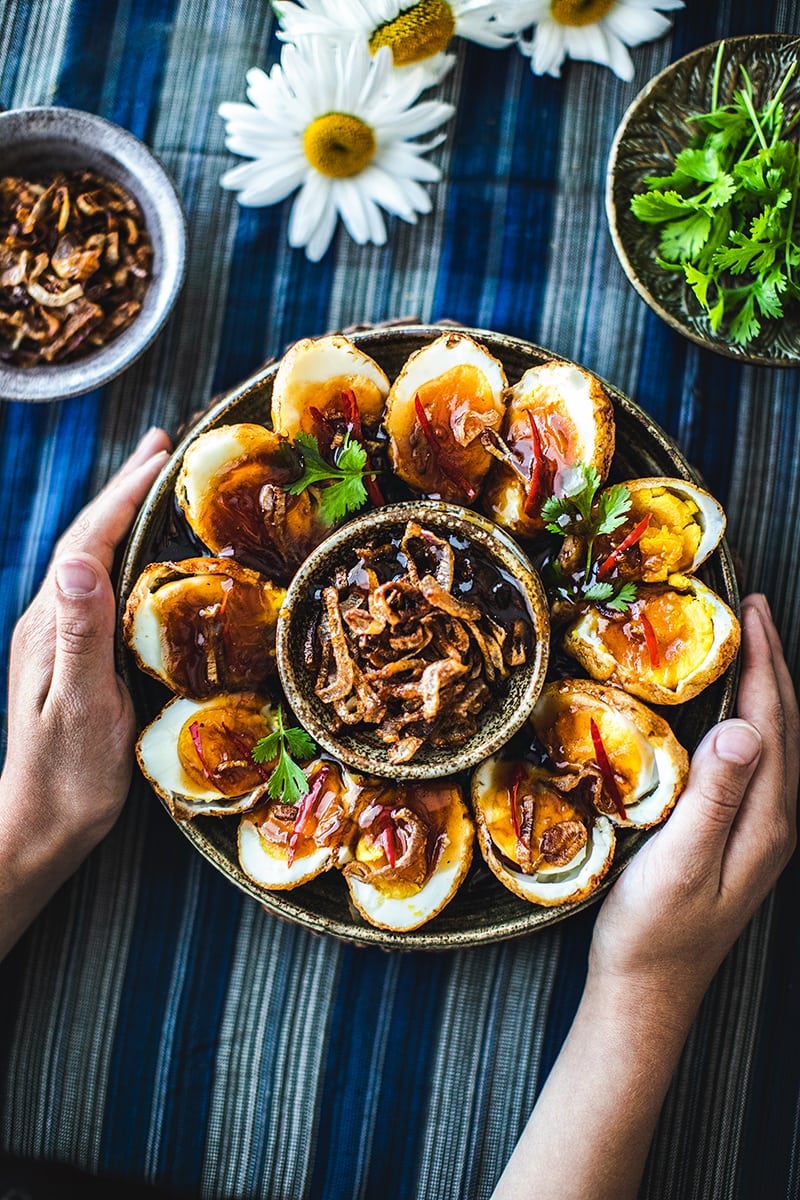
My Thai friends shared fresh duck eggs with me this past weekend, and a few tasty dishes immediately came to mind. One of them is this Thai son-in-law egg recipe.
If you have duck eggs, this is a good recipe to try. Chicken eggs will not disappoint if you don’t have duck eggs. I tested this recipe using duck and chicken eggs, knowing not everyone has access to duck eggs. The secret is in the sauce, and I have a good one for you to try. Let’s get started!
Jump to:
- Why You'll Love This Recipe
- The legend of the son-in-law eggs recipe
- How Son-in-law's eggs are prepared
- Ingredients for Thai son-in-law eggs recipe
- Son-in-Law sauce (Pad Thai sauce)
- How to Make Thai Son-in-Law Eggs Recipe
- Garnishing Options
- Helpful Kitchen Notes and Tips
- Where to buy ingredients for the Kai Look Keuy
- Helpful Kitchen Tools for Making Kai Look Keuy
- What to Serve With Thai Son-in-Law Eggs
- Variations on Thai son-in-law eggs (Kai Look Keuy)
- Substitutes
- Storage
- Frequently Asked Questions
- Related Thai Recipes You'll Love
- Conclusion
- Thai son-in-law eggs (Kai Look Keuy)
Get ready to embark on a culinary adventure as we explore the flavors of Thailand with the classic Thai dish - Thai Son-in-Law Eggs, also known as "Kai Look Keuy"
(ไข่ลูกเขย). Despite its amusing name, this popular snack from Thai cuisine will win your heart with its contrasting textures and delightful taste.
Why You'll Love This Recipe
- It's delicious! Thai Son-in-Law Eggs offer a unique combination of soft-boiled eggs with crispy exteriors bathed in a sweet and sour tamarind sauce.
- Addictive flavors and texture. The creamy insides of the eggs complement the crispy fried shallots and tangy sauce, creating an explosion of flavors in every bite.
- A fun history and story! This dish is a feast for your taste buds and a conversation starter with its humorous name and intriguing history. Check out the legend section below.
- Son-in-law eggs as an appetizer. This dish is a perfect Thai starter recipe for dinner parties. My guests go wild each time I serve this dish. Beware, they disappear fast. Very fast. It’s always a good idea to double up on the recipe if serving at a dinner party or potluck. Try it for your next gathering!
The legend of the son-in-law eggs recipe
Thai Son-in-Law Eggs, or "Kai Look Keuy," is a beloved Thai snack by the Thai people and others alike. The name "Son-in-Law Eggs." The origin of this dish comes from a rumored story that a mother-in-law would prepare this dish to show her soon-to-be daughter's husband a glimpse into his future and the future of his (lack of) offspring if he dared mistreat her daughter.
The mother's (or father's too?) passive-aggressive gesture of using deep-fried pair of eggs, duck eggs, not his, became a legend of a story, varied in many versions and interpretations. I won't get into R-rated details but try to imagine, without giggling, the future son-in-law's face as his loving mother-in-law preparing the eggs for them to enjoy. Ok, let's move on to food prep next. (;
How Son-in-law's eggs are prepared
The soft-boiled eggs are deep-fried to a golden brown, symbolizing a delicate balance between the daughter's family and the groom. Despite its light-hearted origin, Thai Son-in-Law Eggs have become a popular dish that many beyond Thai culture enjoy.
Ingredients for Thai son-in-law eggs recipe
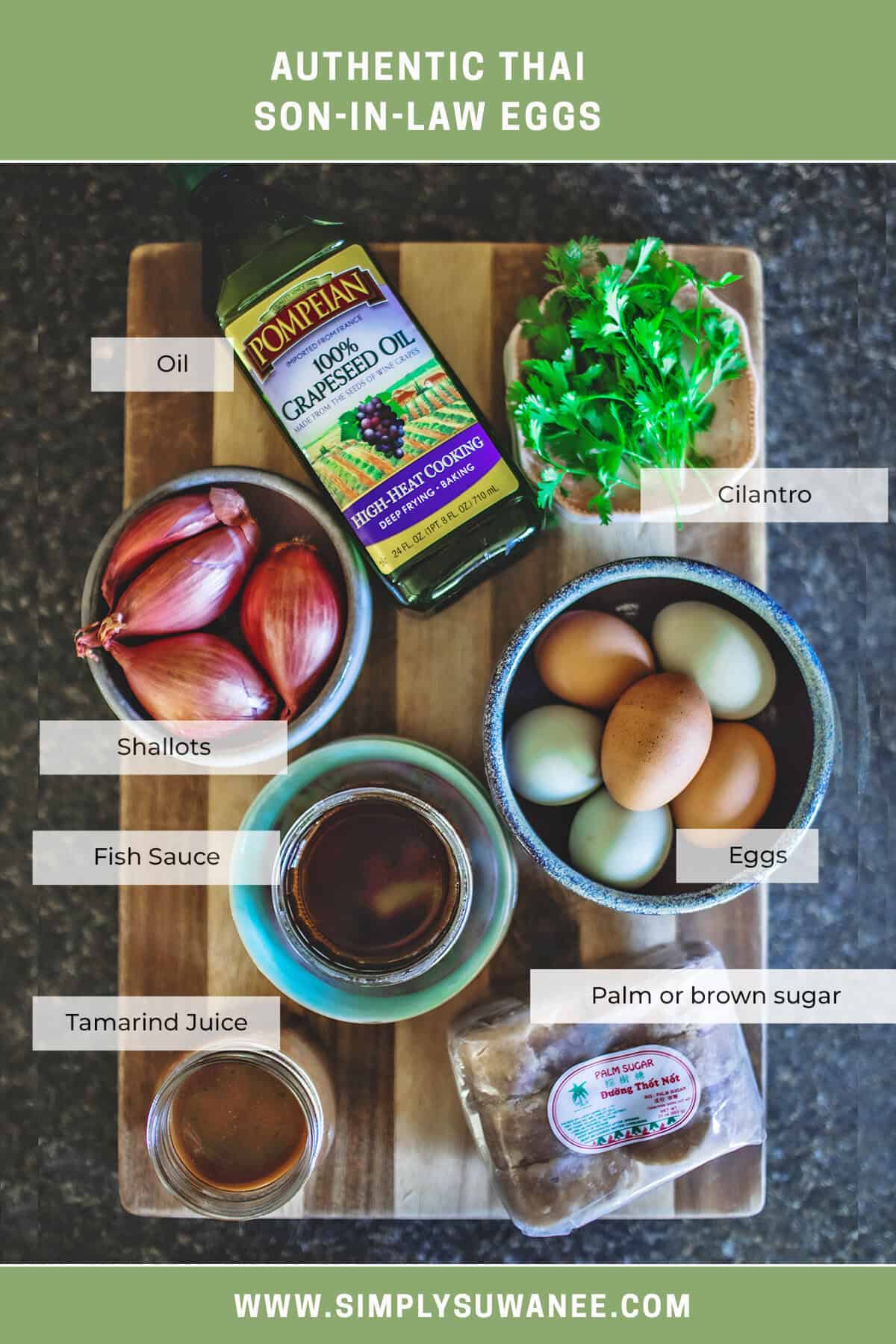
- Fresh duck eggs or chicken eggs. We will be using medium-boiled eggs for this recipe. Duck eggs can be found in Asian markets.
- Frying oil. You'll need to have enough oil for deep frying the eggs.
- Tamarind paste or tamarind concentrate. Or make your own tamarind paste here.
- Palm sugar. White, brown sugar, or cane sugar for substitutes. Learn more about palm sugar here—
- Fish sauce. Use any fish sauce and adjust the sauce as needed before serving.
- Shallots. Crispy fried
- Sliced red peppers or hot peppers flakes (optional)
- Fresh cilantro (for garnish)
Son-in-Law sauce (Pad Thai sauce)
The sauce used for the Son-in-law's eggs is the same sweet tamarind sauce used in my authentic Pad Thai recipe. Or a slightly different homemade Pad Thai sauce recipe will work for this sauce too. It has added garlic and shallot for extra flavors and textures.
You can either buy tamarind concentrate or make your own paste from the pulp. Check out my homemade tamarind paste made from the tamarind pulp here. If you are unfamiliar with tamarind, check out this post, where I explain what tamarind is.
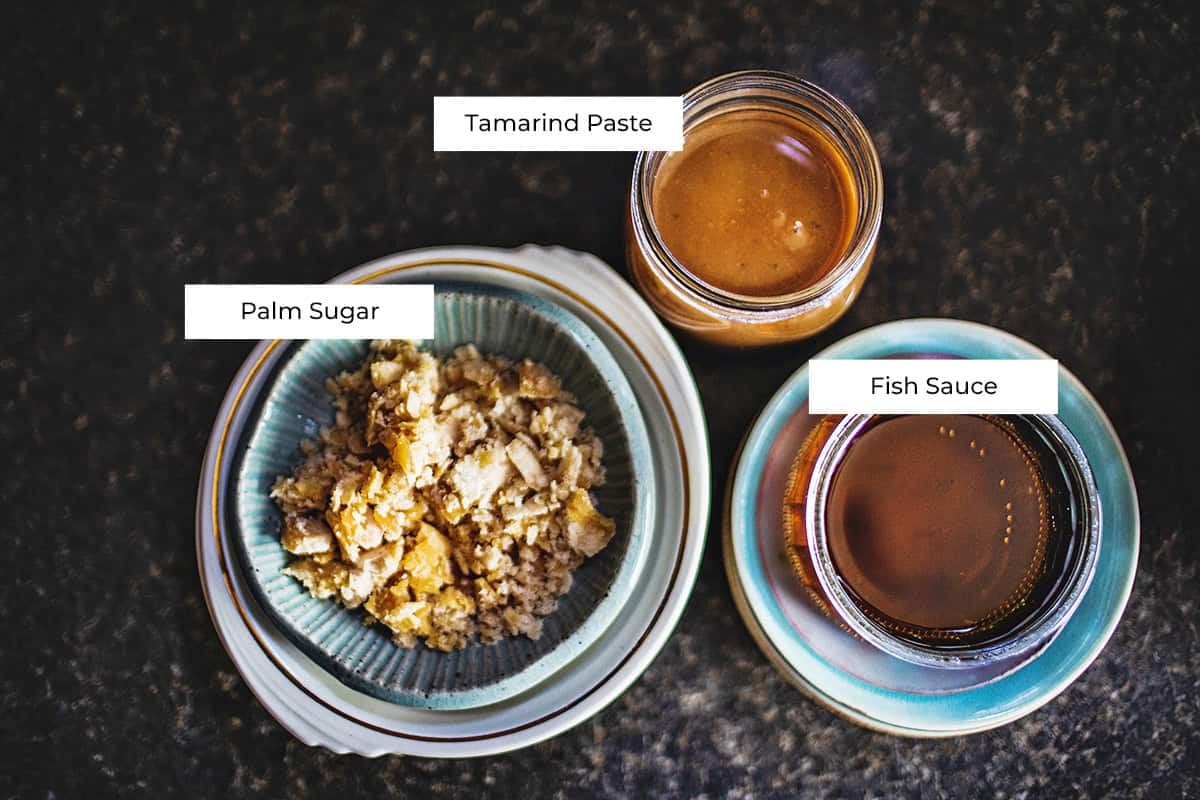
How to Make Thai Son-in-Law Eggs Recipe
Step 1. Begin by preparing the eggs. Make hard or medium-boil the eggs to achieve the perfect balance of soft yolks and firm exteriors. Once done, plunge the boiled eggs into cold water to help with easy peeling. Peel the eggs and set them aside to cool at room temperature.
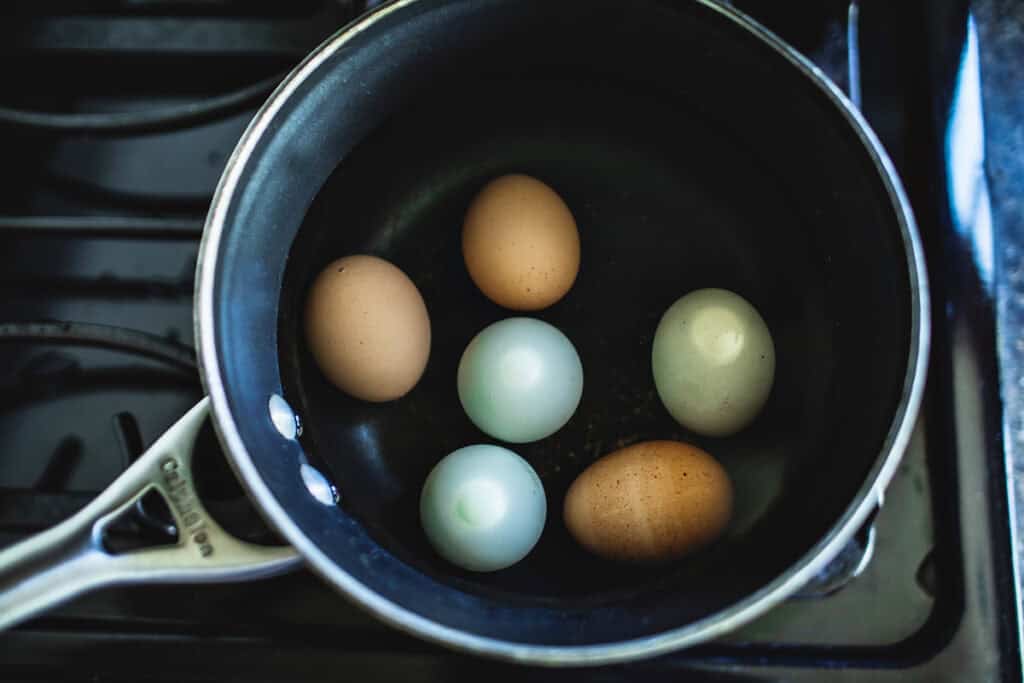
Step 2. Fry the sliced shallots in oil at medium-low heat until light brown, 5-7 minutes. Remove with a strainer and set aside to cool. Use store-bought fried shallots or this homemade recipe to make crispy fried shallots for more detailed instructions.
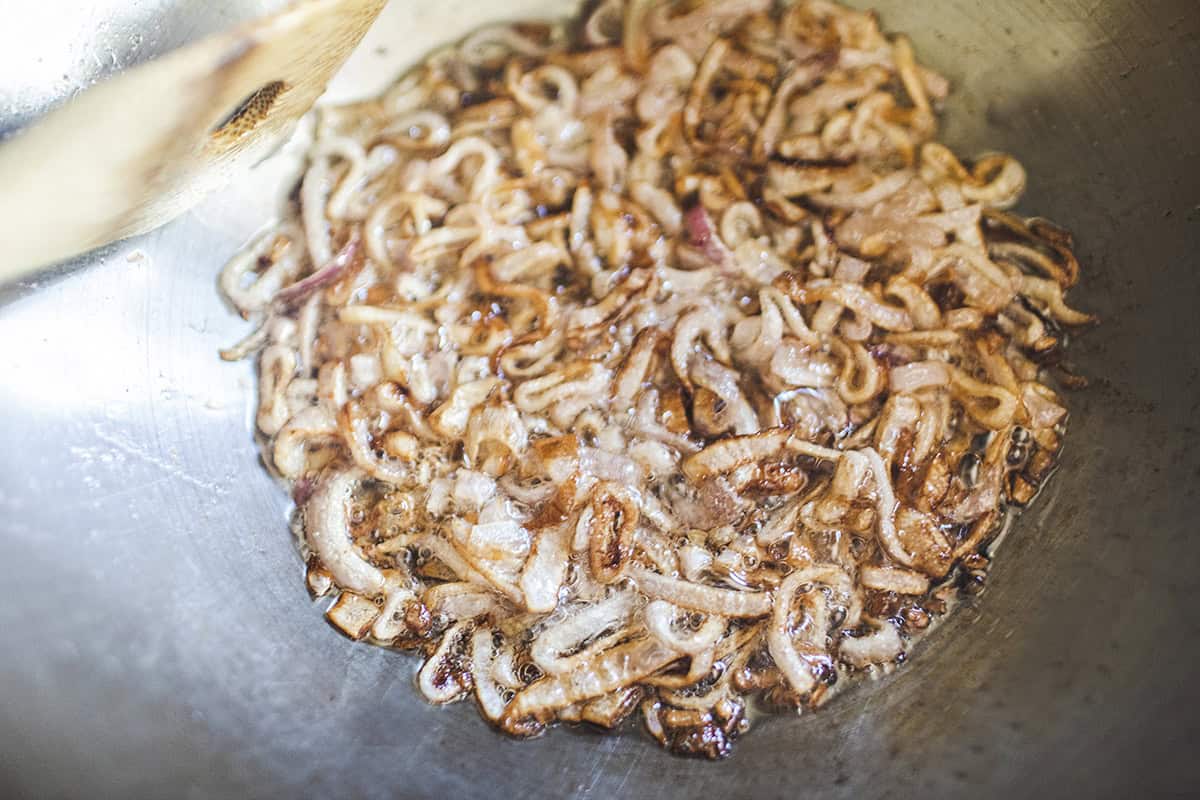
Step 3. Next, we will be deep-frying the eggs. Deep fry the hard-boiled eggs in hot oil until the outer surface of the eggs, the egg white part, turns golden brown and lightly crispy. Remove the eggs with a slotted spoon or a strainer into a serving dish lined with paper towels and let cool.
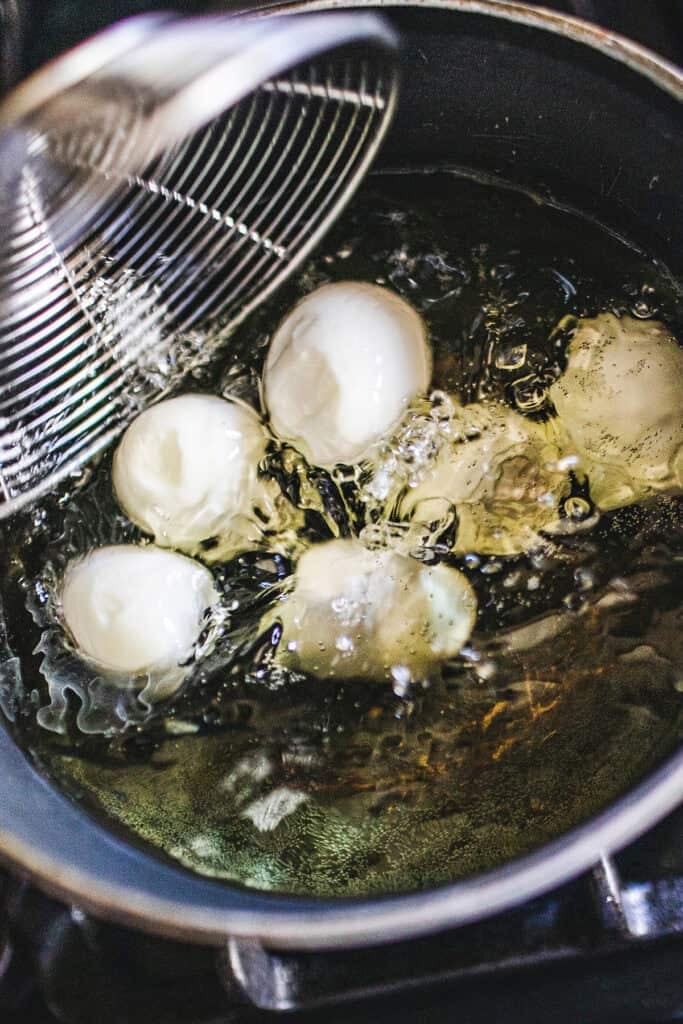


Step 4. Make the dressing by combining tamarind juice, fish sauce, and sugar. Simmer in a saucepan over medium heat, stirring often with a whisk or wooden spoon until sugar dissolves and the sauce thickens to the consistency of maple syrup.
Adjust with more sugar, fish sauce, or tamarind paste as needed. The flavor tends to lean towards a sour note. But adjust for your own taste buds! Set aside for drizzling over the eggs later.

Step 5. Next, slice the eggs with a sharp knife. A small serrated knife helps. Slice the eggs in half and plate the halved eggs on a serving platter. Drizzle the dressing evenly over the top of the eggs.

Step 6. Add fried shallots, cilantro, and red peppers to taste. Pour any leftover sauce into a small bowl and serve that with the eggs! That’s it. Enjoy!

Garnishing Options
Once the eggs are fried to a golden brown, garnish the dish with crispy fried shallots, deep-fried crispy garlic, sliced hot peppers, and fresh coriander leaves. These garnishes enhance the flavors and add a delightful pop of color.
Helpful Kitchen Notes and Tips
- Use a slotted spoon to carefully lower the eggs into the hot oil to prevent splattering.
- Strain and save the excess oil for use if it's not too burned or diluted with egg particles.
- Adjust the level of spiciness in the sauce by adding more or fewer hot pepper according to your preference.
- To achieve the right consistency of the tamarind sauce, dissolve the tamarind paste or concentrate in hot water before adding the other ingredients.
Where to buy ingredients for the Kai Look Keuy
I highly recommend going to your nearest Asian market to buy a few ingredients for this recipe. If you prefer not to shop right now, check out these links to make online purchases and have them delivered right to your front steps! (Affiliate Links)
- Fried Shallots (or make your own crispy fried shallots with this simple recipe)
Helpful Kitchen Tools for Making Kai Look Keuy
- A sharp knife for slicing and shredding shallots and hot peppers.
- A serrated knife for slicing the fried eggs
- A saucepan or small skillet for frying the shallots.
- A deep-frying pan or deep fryer for frying the eggs.
What to Serve With Thai Son-in-Law Eggs
Thai Son-in-Law Eggs are often served with a bowl of fragrant jasmine rice. Combining crispy eggs and fluffy rice makes for a satisfying and comforting meal.
Add generous Thai crispy fried shallot or crispy fried garlic on the side or garnish.
Variations on Thai son-in-law eggs (Kai Look Keuy)
- For a vegetarian version, use firm tofu instead of eggs and follow the same frying process to achieve crispy exteriors.
Substitutes
- If fresh tamarind is unavailable, fresh lime juice is an excellent substitute for the tamarind paste.
Storage
Thai Son-in-Law Eggs are best enjoyed fresh, but any leftovers can be stored in an airtight container in the refrigerator for up to 2 days. Reheat the eggs in a frying pan over low heat before serving.
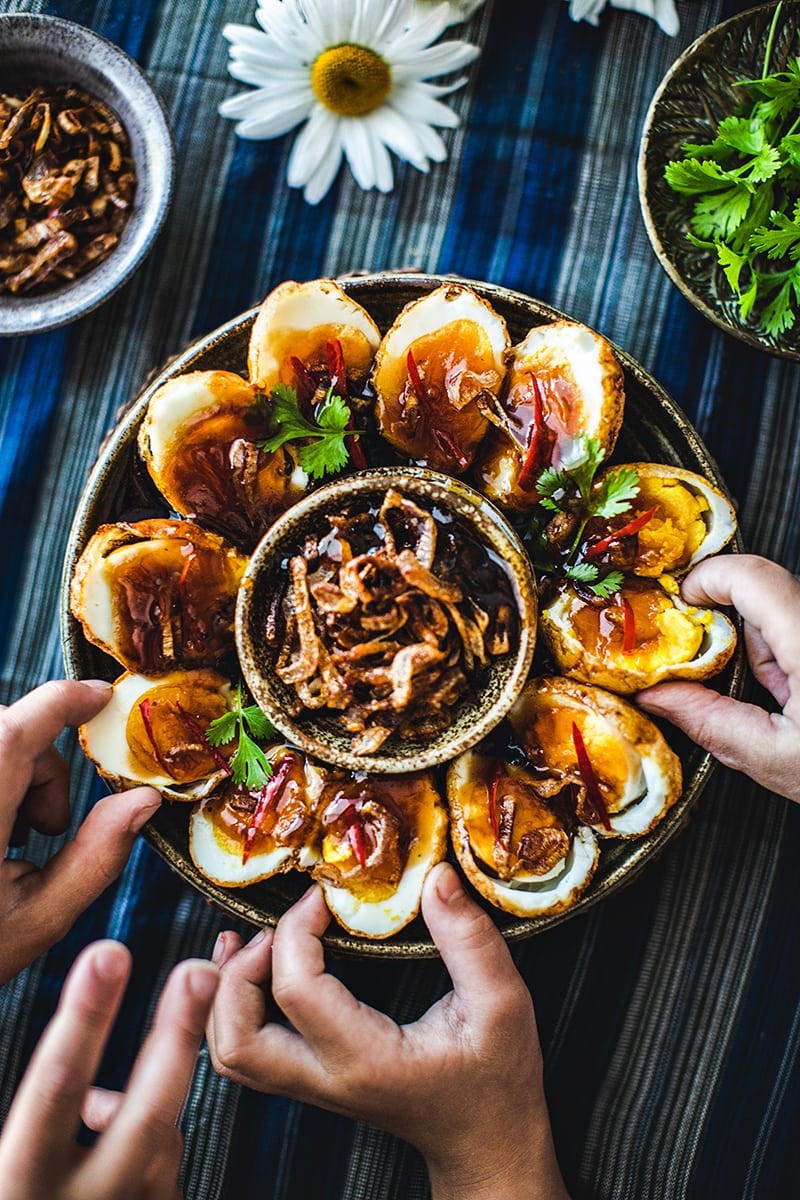
Frequently Asked Questions
The name "Son-in-Law Eggs" originated from a Thai tradition where a mother would make these eggs to impress her son-in-law. It's a fun and playful name for this dish.
Yes! You can use chicken eggs instead of duck eggs in the recipe. The taste might be slightly different, but it will still be delicious.
To achieve the right consistency for the tamarind sauce, start by adding a small amount of water to the tamarind pulp and let it soak for a few minutes. Then, using a strainer, separate the liquid from the pulp. Gradually add water to the liquid until you reach a thick yet pourable consistency.
Absolutely! You can make a larger batch of the tamarind sauce and store it for later use. Just make sure to keep it in an airtight container and refrigerate it. It should last for a few weeks, and you can easily use it whenever you want.
Related Thai Recipes You'll Love
If you enjoy Thai Son-in-Law Eggs, you might also love these other Thai favorites.
- Easy Pad Thai Recipe (sweet and sour sauce)
- 3-minute chili dipping sauce
- What is palm sugar and how to use it in Thai cooking
- What is Tamarind and how to use it in Thai cooking
- Mango Sticky Rice
Conclusion
Thai Son-in-Law Eggs, with their humorous name and delectable taste, is a must-try dish for anyone eager to explore the rich flavors of Thai cuisine. Whether serving it as a delightful snack or as part of a scrumptious meal, this simple recipe is worth trying and sharing with friends and family.
So, roll up your sleeves, fry those eggs to a crispy golden brown, and savor the magical blend of sweet, sour, and spicy Thai flavors in every bite of Thai Son-in-Law Eggs.
Love these recipes? If you do, please leave a 5-star rating in the recipe card below and/or a review in the comments section below the page, and follow me on Facebook, Pinterest, and Instagram!
Print
Thai son-in-law eggs (Kai Look Keuy)
- Total Time: 35 minutes
- Yield: 4
- Diet: Gluten Free
Description
Thai son-in-law eggs (Kai Look Keuy) is a simple recipe that uses hard-boiled eggs, deep-fried until the skin is golden brown, then served with a perfectly balanced dressing made from tamarind juice, fish sauce, and palm sugar.
Ingredients
Fried Shallots
- 1 cup sliced shallots
- ½ cup oil (high smoke point oil, such as grapeseed, vegetable, or canola oil)
Medium to hard-boiled eggs
- 6 eggs (raw, uncooked duck or chicken eggs)
- water (enough to submerge the eggs for hard boiling)
- 2 cups oil (high smoke points oil like grapeseed oil, vegetable oil, or canola oil )
Dressing
- ½ cup palm Sugar or brown sugar
- ¼ cups tamarind concentrate
- 2 tablespoons fish sauce
Garnishes
- Fried Shallots (or make your own crispy fried shallots with this simple recipe)
- Cilantro leaves, chopped for garnishing
- fresh or dried red peppers. Use Thai peppers for the extra heat or red bell peppers for the extra crunch and color.
Instructions
- Begin by preparing the eggs. Make hard or medium-boil the eggs to achieve the perfect balance of soft yolks and firm exteriors. Once done, plunge the boiled eggs into cold water to help with easy peeling. Peel the eggs and set them aside to cool at room temperature.
- Fry the sliced shallots in oil at medium-low heat until light brown, 5-7 minutes. Remove with a strainer and set aside to cool. Use store-bought fried shallots or this homemade recipe to make crispy fried shallots for more detailed instructions.
- Next, we will be deep-frying the eggs. Deep fry the hard-boiled eggs in hot oil until the outer surface of the eggs, the egg white part, turns golden brown and lightly crispy. Remove the eggs with a slotted spoon or a strainer into a serving dish lined with paper towels and let cool.
- Make the dressing by combining tamarind juice, fish sauce, and sugar. Simmer in a saucepan over medium heat, stirring often with a whisk or wooden spoon until sugar dissolves and the sauce thickens to the consistency of maple syrup.
- Adjust with more sugar, fish sauce, or tamarind paste as needed. The flavor tends to lean towards a sour note. But adjust for your own taste buds! Set aside for drizzling over the eggs later. Next, slice the eggs with a sharp knife. A small serrated knife helps. Slice the eggs in half and plate the halved eggs on a serving platter.
- Drizzle the dressing evenly over the top of the eggs. Add fried shallots, cilantro, and red peppers to taste. Pour any leftover sauce into a small bowl and serve that with the eggs! That’s it. Enjoy!
Notes
- Use a slotted spoon to carefully lower the eggs into the hot oil to prevent splattering.
- Strain and save the excess oil for use if it's not too burned or diluted with egg particles.
- Adjust the level of spiciness in the sauce by adding more or fewer hot pepper according to your preference.
- To achieve the right consistency of the tamarind sauce, dissolve the tamarind paste or concentrate in hot water before adding the other ingredients.
** Thank you so much for visiting my blog! This is truly a passion for me. If you have enjoyed these recipes and appreciate the hard work I put into them, I would love it if you would share them with your friends! Your recommendation is the highest review I could hope for, and I’d appreciate it! **
- Prep Time: 10
- Cook Time: 20
- Category: Appetizers
- Method: Frying
- Cuisine: Thai

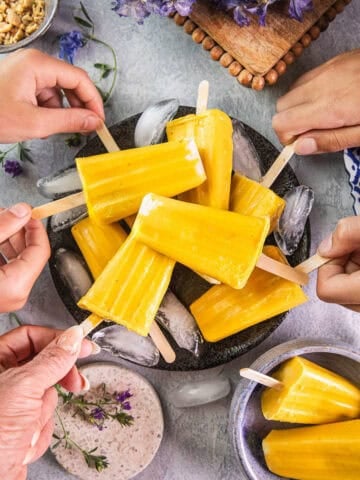



Suwanee says
Hi CVDay,
Thank you for letting me know. Can you tell me more or send me a picture of what you are getting? Having them sit in cold water will affect the frying. I will test this recipe again with and without the ice bath.
CVDay says
I am not getting the same results with deep frying the eggs. They are not getting the same thick fried coat like in your pictures. Any idea what the issue is? Would it have anything to do with letting them sit in ice-cold water before the deep fry?
Suwanee says
Hi Trish,
It's hard to find a substitute for fish sauce but perhaps try using tamari. I have never done that before, so let me know how it turns out if you do. Thanks!
trish says
is there a substitute for the fish sauce that would work?
Suwanee says
Hi Angela, the eggs are going to be extremely hot right after frying, I would wait for them to cool for a few minutes. The sauce is also very hot right before pouring. So I'd wait just a couple of minutes before eating so you don't burn yourself.
Angela says
These look so yummy! Is it best to serve the eggs while they’re still warm from frying?